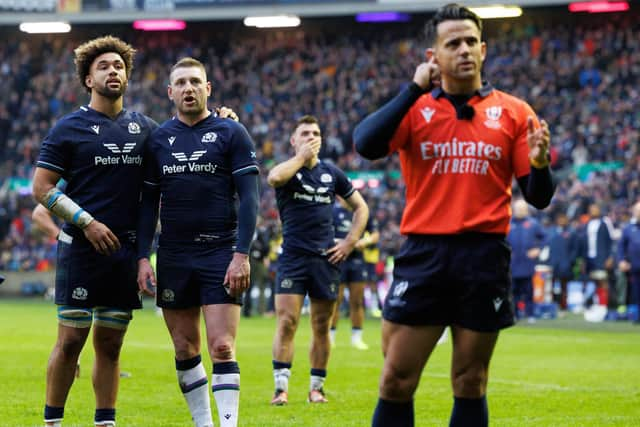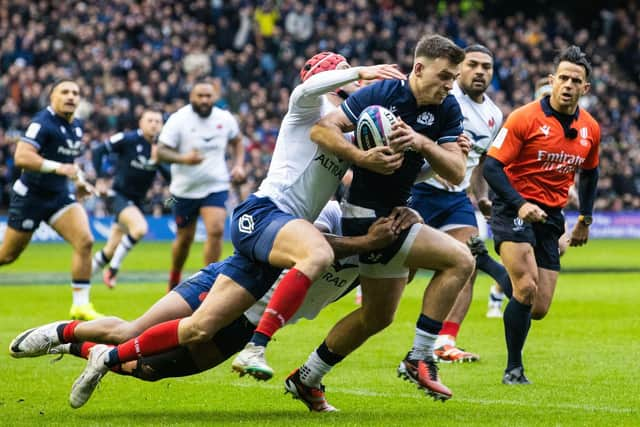Fraser Brown: World Rugby needs to embrace the game’s physicality not quell it as it considers law changes
Rugby at the elite level is fundamentally a physical sport and I think the game’s ruling body needs to understand that a lot of people enjoy watching rugby not just for the high level of skill on show but because they like the physicality and brutality of a contact sport.
We shouldn’t move away from this; it is a massive marketing point and should be in the forefront of the minds of the lawmakers as they consider changes to the game.
Advertisement
Hide AdAdvertisement
Hide AdWorld Rugby last week revealed plans aimed at “reimagining rugby’s entertainment factor” and broadening the sport’s appeal. The raft of proposals included 20-minute red cards, different ways of speeding the game up, including a streamlined TMO system, and an adjustment to the onside law designed to stop ‘kick tennis’, or ‘Dupont’s law’ as it’s become known. There is also to be a working group to look at the impact of lowering the tackle height in community rugby and to consider its “appropriateness” for elite rugby.


I think the tackle height is right as it is just now in the professional game. By all means have it lower in the community game; it reinforces good tackle technique, creates a lower risk environment when it comes to head contact and takes away the element of doubt from an officiating point of view. But I think in the elite game there are already the protocols in place which are designed to try to stop unnecessary contact to the head and neck.
Obviously, we want rugby to be safe and officiated properly and the onus should be on the players in this regard. But it’s important to harness rugby’s strengths in the right way. Fundamentally, if we want rugby to grow, we should be focusing on its physicality and the collisions as well as its pace, evasiveness and skill-set. There is room for both. If you look across the Atlantic, it’s why American football is so loved: it’s because of the collisions. In a lot of occasions, the physicality, the brutality, the power in the collisions enhances the skill-sets on show. Quarterbacks finding a pinpoint pass whilst being flattened a split second later. Rugby league's NRL is the same. The sight of a 110kg outside back taking flight with an acrobatic finish in the corner is an awesome sight. The athleticism of the modern player should be placed front and centre, and the sport’s physicality should be used as a major marketing tool, not something to be quelled.
If you drop the tackle height, you are alienating a lot of people who like that side of the game. We can mitigate the risk with policing of the existing tackle height, and enforcing stricter punishments for those who are clearly reckless.
As for 20-minute red cards, I don’t like this at all and I don’t understand why it is being considered. It proposes that a player sent off is replaced by a substitute after 20 minutes has elapsed and it’s rumoured to being pushed hard by New Zealand who, funnily enough, were the team who suffered when one of their players - Sam Cane - was red-carded in the World Cup final.


Red cards are there to stop malicious and dangerous actions. If you don’t want to be sent off, don’t tackle high. The caveat to that is the need to tidy up the process around head collisions, particularly around the accidental ones where I feel more power needs to be given back to the officials on the pitch to use their judgment to decide whether it was reckless or malicious or just an accidental collision.
At the moment, referees have their hands tied. Instead of being able to use their own judgment, you hear them having conversations where they are trying to find mitigation to see whether they can reduce the punishment or running through a checklist of things as to why it is or isn’t foul play. If you give more power back to the referee then the 20-minute red card plan becomes irrelevant because it’s just about the referee being accountable for his or her decisions.
In essence, a red card must stay as a red card. It’s a punishment for ill-discipline and recklessness and the team should suffer.
The move to get rid of ‘Dupont’s Law’ is a positive one.
Advertisement
Hide AdAdvertisement
Hide AdIt might not have the biggest impact on the game but it’s an obvious point of contention after what happened in the Scotland v France Six Nations game which exposed that trend of back-and-forth kicking as players waited in the middle of the pitch.
The hope is that it will stop the kicking battles and also create more space in the middle. The result will likely be less kicking, or at least the kicking will be more structured. Teams will counter attack and take that mid-pitch space and if they can manipulate the back field they can start putting the ball through after a phase or two.
Closing this loophole can only be a good thing. Gregor Townsend said at the time that it was a blight on the game, and he’s right. It’s not been good for rugby, not good for the spectacle and certainly doesn’t aid attacking rugby. It also allowed the less athletically conditioned teams to get away with playing less rugby because their players can effectively take a break during the kick battles.
As part of the effort to enhance rugby’s entertainment factor a lot of the proposals are aimed at speeding up the game.
One strand is to do away with opting to take a scrum from a free kick which I guess they think will speed up the game but where do you draw the line? If teams have a poor scrum, could they then give away a free-kick offence because they know their opponents can’t get a scrum from it? It’s a possible unintended consequence. I just think that if the refereeing around the scrum is better we make better decisions and we don’t need to bring in gimmicks like taking away the option to scrum off a free kick.
I think speeding up the game is a good thing and it is proposed that the shot clock that was introduced a couple of years ago for place-kicking should now be used for scrums and lineouts. I’m in favour for the latter but not the former.
My concern is that you might see more collapsed scrums because tired individuals will be rushing to get scrums set. It’s such a technical area but it’s also such a dangerous area. Thankfully, we don’t see many catastrophic injuries in and around the scrum but in every scrum, there are six people who are at risk due to fatigue and the forces that go through them. The argument would be that it would force front-rowers to be fitter, smaller, more conditioned. Front-rowers are some of the most uniquely conditioned athletes on the planet. They run, tackle, pass, carry, clear, maul - as well as scrum! How about we cut them a little slack and take some time to officiate this area of the game better, rather than criticise those at the coal-face?
I’d be in favour of a shot clock at the lineout. A rule banning teams from going into a huddle at lineouts was brought in and it lasted all of two weeks. How many teams did we see in the Six Nations slowing it down, going into a huddle, getting the call then going back to the touchline? So I’m all for trying to speed the game up when the ball’s gone into touch and a shot clock at the lineout should help in that regard.
Advertisement
Hide AdAdvertisement
Hide AdWorld Rugby also wants to change the way the TMO is used but haven’t put out any detail as yet.
I think we all agree it’s taking too long to get images up on the big screen and for officials to come to a decision. Anyone who watched the end of Scotland’s game with France can relate to that. World Rugby is not happy with the stop-start nature of the TMO process and the amount of time that is being lost to the game. It also varies too much in different countries, with French TV producers famously reluctant to put up pictures that show French players doing anything wrong.
So they’ve expressed a desire to streamline the TMO process without revealing yet how they intend to do that, and I think everyone would be in broad agreement that this is something that needs done.
Comments
Want to join the conversation? Please or to comment on this article.
